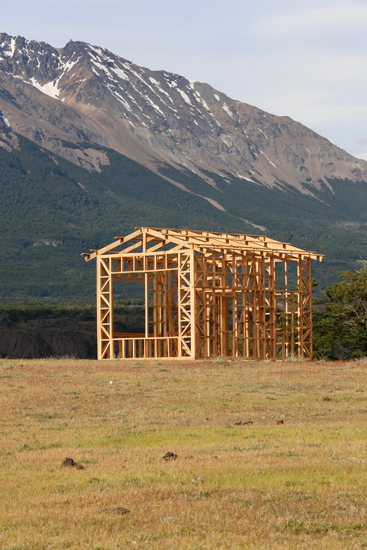Rarely do curators at large public museums co-ordinate concurrent exhibitions to complement each other. But by chance or design, the Museo de Arte Contemporáneo (MAC) in Santiago, Chile, is bucking the trend. Of the half-dozen or so solo exhibitions currently on show, there are three which share a common material interest: wood. They form, if you will, a little copse, and each one blossoms in the company of its neighbours.
The smallest of the three documents an ongoing series of actions by Teresa Aninat. Under the title Otros Viejas (Other Journeys), the artist has photographed herself (or had herself photographed) in a variety of different locations throughout Chile: a rooftop helipad, a snow-swathed forest, the back of a disused train. In each case she brings with her a collection of tree branches. In some images, these branches appear like the control bar of a marionette; in some they function like a kind of staff or walking stick. In others, the artist simply drags them along behind her, leaving a scrawling trail in the dust and snow.

Each image has been printed in the form of a postcard, and given out to members of the public, who have then been asked to mail them back to a PO Box for inclusion in the exhibition. Most seem to have arrived safe and sound, and are displayed ingeniously and beautifully: in row upon row of upright slots along the length of long wooden table. Round the wall hang the branches themselves, as well as receipts or tickets (I’m not sure what for) framed, again with some style. Between the undercurrent of solitary ritual and the elegant presentation, the artist seems to be presenting herself as a kind of lost traveller, but one who only exists within complex networks of association (landscapes, photographs, even the postal service).
Taking up significantly more of the space at MAC is Patrick Steeger’s Uso y Abuso (Use and Abuse), the centrepiece of which is a large-scale participatory installation on the ground floor of the 19th century neoclassical building. Two wooden crates contain thousands of small, white-painted wooden pieces – like irregular Lego blocks – made of old balustrades or skirting. Visitors are encouraged to construct their own little buildings or cities (or anything they like). Each adult revives that peculiarly pointless omnipotence that is shared both by the urban masterplanner and the toddler. Looking over our endeavours, a charred watchtower casts the shadow of surveillance.
Each adult revives that peculiarly pointless omnipotence that is shared both by the urban masterplanner and the toddler.
In several smaller spaces off the museum’s first-floor balcony, Steeger presents his diverse experiments with wood. Working with hugely powerful Chilean forestry company Arauco, the artist seeks to push the material to the very limits of its capabilities, and occasionally beyond (hence the slightly hackneyed title). Steeger’s work ranges from small models to ceiling-hung structures, and, most memorably, a walk-in ovoid installation, whose exterior is grey and supple and as soft to the touch as moleskin. The artist explores the materiality of wood – its flexibility and rigidity, its roughness or regularity – and deftly exploits the aesthetics of contrasting tones and textures.

Taking an approach that extends beyond the material and the aesthetic are Chile’s Sebastián Preece and Olaf Holzapfel, from Germany, whose collaborative project, Housing in Amplitude, takes up the entirety of MAC’s lower ground floor. The show follows a lengthy residency in the Aysén region of Patagonia, in which the duo learnt about the lifestyles, architecture and house-building techniques of the farmers and herdsmen of Patagonia. On display are a series of wooden structures that were originally exhibited on-site in Patagonia. They exist both as installation pieces and architectural proposals for a nomadic lifestyle: cattle-gates, fence posts, a modular framework for a small house, various roofs of overlapping wooden ‘tiles’ (like armour or a fish’s scales).

In the corner is second wood-framed house, this one covered in galvanised steel. Inside it plays a film: a Chilean farmer declaiming fast, rhythmic poetry inside one of these houses. His heavily calloused hands turn browned pages of verse. He grins under a silver moustache to reveal a gappy smile. The family and friends around him smile too. The camera lingers on a hillside – utterly deforested, except some sad serrated rows of wrenched silver tree trunks. Each plot of land is delineated from the next by lines of slim wooden fence-posts: wood demarcating wood.
The second film takes place inside a timber processing plant. We sit and watch as trees enter – mossy-barked and irregular – to be skinned and trimmed and sliced up into precise lengths of timber. The bulk of the film is a close-up of the rhythmic repetition of the wood-cutting machinery (a Wood Mizer sawmill), operating continuously with only fleeting intervention from its human operators. The film foregrounds both the complexity and the mechanised speed of the process by which a tree is turned into wood: from living thing to mere material. A kind of sadness emerges. It touches all the work in these three concurrent exhibitions, and it lingers, I realise, in the very bench I’m sitting on to watch it.
Utros Viejas, Uso y Abuso, and Housing in Amplitude are at MAC, Santiago, Chile until 15th June 2014.

